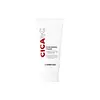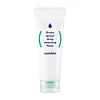What's inside
What's inside
 Key Ingredients
Key Ingredients

 Benefits
Benefits

 Concerns
Concerns

No concerns
 Ingredients Side-by-side
Ingredients Side-by-side

Glycerin
HumectantWater
Skin ConditioningSodium Cocoyl Isethionate
CleansingGlycol Distearate
EmollientPotassium Cetyl Phosphate
EmulsifyingDisodium Laureth Sulfosuccinate
CleansingDisodium Cocoyl Glutamate
CleansingSodium Citrate
BufferingPropanediol
SolventCitric Acid
BufferingCaprylyl Glycol
EmollientHydroxypropyl Starch Phosphate
Betaine
HumectantNiacinamide
SmoothingCentella Asiatica Leaf Extract
Skin ConditioningDisodium EDTA
Ethylhexylglycerin
Skin ConditioningMelaleuca Alternifolia Leaf Oil
AntioxidantEucalyptus Globulus Leaf Oil
PerfumingDipropylene Glycol
Humectant1,2-Hexanediol
Skin Conditioning2,3-Butanediol
HumectantTotarol
AntioxidantSodium Hyaluronate
HumectantCandida Bombicola/Glucose/Methyl Rapeseedate Ferment
AntimicrobialCapryloyl Salicylic Acid
ExfoliatingHelianthus Annuus Seed Oil
EmollientGluconolactone
Skin ConditioningGlycolic Acid
BufferingSalicylic Acid
MaskingTromethamine
BufferingHydrogenated Lecithin
EmulsifyingGlycerin, Water, Sodium Cocoyl Isethionate, Glycol Distearate, Potassium Cetyl Phosphate, Disodium Laureth Sulfosuccinate, Disodium Cocoyl Glutamate, Sodium Citrate, Propanediol, Citric Acid, Caprylyl Glycol, Hydroxypropyl Starch Phosphate, Betaine, Niacinamide, Centella Asiatica Leaf Extract, Disodium EDTA, Ethylhexylglycerin, Melaleuca Alternifolia Leaf Oil, Eucalyptus Globulus Leaf Oil, Dipropylene Glycol, 1,2-Hexanediol, 2,3-Butanediol, Totarol, Sodium Hyaluronate, Candida Bombicola/Glucose/Methyl Rapeseedate Ferment, Capryloyl Salicylic Acid, Helianthus Annuus Seed Oil, Gluconolactone, Glycolic Acid, Salicylic Acid, Tromethamine, Hydrogenated Lecithin
Water
Skin ConditioningGlycerin
HumectantHydrogenated Palm Acid
Potassium Hydroxide
BufferingSodium Hyaluronate
HumectantHyaluronic Acid
HumectantHordeum Distichon Extract
Skin ProtectingTriticum Vulgare Sprout Extract
Skin ConditioningPhaseolus Radiatus Sprout Extract
HumectantBrassica Oleracea Italica Sprout Extract
EmollientGlyceryl Stearate
EmollientAcrylates/C10-30 Alkyl Acrylate Crosspolymer
Emulsion StabilisingSodium Phytate
Butylene Glycol
HumectantPolyquaternium-7
Pentylene Glycol
Skin Conditioning1,2-Hexanediol
Skin ConditioningOctanediol
Capryloyl Salicylic Acid
ExfoliatingNiacinamide
SmoothingEthylhexylglycerin
Skin ConditioningAscorbic Acid
AntioxidantSodium Benzoate
MaskingRosmarinus Officinalis Leaf Oil
MaskingWater, Glycerin, Hydrogenated Palm Acid, Potassium Hydroxide, Sodium Hyaluronate, Hyaluronic Acid, Hordeum Distichon Extract, Triticum Vulgare Sprout Extract, Phaseolus Radiatus Sprout Extract, Brassica Oleracea Italica Sprout Extract, Glyceryl Stearate, Acrylates/C10-30 Alkyl Acrylate Crosspolymer, Sodium Phytate, Butylene Glycol, Polyquaternium-7, Pentylene Glycol, 1,2-Hexanediol, Octanediol, Capryloyl Salicylic Acid, Niacinamide, Ethylhexylglycerin, Ascorbic Acid, Sodium Benzoate, Rosmarinus Officinalis Leaf Oil
Ingredients Explained
These ingredients are found in both products.
Ingredients higher up in an ingredient list are typically present in a larger amount.
1,2-Hexanediol is a synthetic liquid and another multi-functional powerhouse.
It is a:
- Humectant, drawing moisture into the skin
- Emollient, helping to soften skin
- Solvent, dispersing and stabilizing formulas
- Preservative booster, enhancing the antimicrobial activity of other preservatives
Capryloyl Salicylic Acid comes from salicylic acid, the famous acne-fighting BHA.
It usually goes by a more common name of LHA, or lipohydroxy acid.
Like salicylic acid, this ingredient is a chemical exfoliant that can help break down the oil in your pores and reduce inflammation.
Though studies for LHA do show it to be less effective than salicylic acid. To be fair, salicylic acid is the reigning monarch of acne treatments.
However, a study from 2009 found LHA to be comparable to BPO, making it a good alternative for people with sensitive skin. Another study of 14 patients found a significant decrease in comedones after using LHA.
Another pro of LHA? It is less irritating than salicylic acid due to its large molecule size.
Large molecules cannot penetrate skin as well, so they are gentler on the skin. LHA is much less penetrative than salicylic acid.
An in-vitro study (not done on a living organism) found only 6% of LHA penetrated past the statum corneum compared to 58% of salicylic acid. An in-vivo (done on a living organism) analysis revealed ~17% of LHA was still present in the top layer of skin after 4 days, versus ~9% of salicylic acid.
Interestingly, a study from 2008 found LHA comparable to another famous acid, glycolic acid.
This study found about 10% of LHA is as effective as 20-50% of glycolic acid in treating hyperpigmentation and fine-lines.
Hydroxy acids have been found to stimulate skin protein, lipids, and thermal thickening. This may have anti-aging benefits.
Learn more about Capryloyl Salicylic AcidEthylhexylglycerin (we can't pronounce this either) is commonly used as a preservative and skin softener. It is derived from glyceryl.
You might see Ethylhexylglycerin often paired with other preservatives such as phenoxyethanol. Ethylhexylglycerin has been found to increase the effectiveness of these other preservatives.
Glycerin is already naturally found in your skin. It helps moisturize and protect your skin.
A study from 2016 found glycerin to be more effective as a humectant than AHAs and hyaluronic acid.
As a humectant, it helps the skin stay hydrated by pulling moisture to your skin. The low molecular weight of glycerin allows it to pull moisture into the deeper layers of your skin.
Hydrated skin improves your skin barrier; Your skin barrier helps protect against irritants and bacteria.
Glycerin has also been found to have antimicrobial and antiviral properties. Due to these properties, glycerin is often used in wound and burn treatments.
In cosmetics, glycerin is usually derived from plants such as soybean or palm. However, it can also be sourced from animals, such as tallow or animal fat.
This ingredient is organic, colorless, odorless, and non-toxic.
Glycerin is the name for this ingredient in American English. British English uses Glycerol/Glycerine.
Learn more about GlycerinNiacinamide is a multitasking form of vitamin B3 that strengthens the skin barrier, reduces pores and dark spots, regulates oil, and improves signs of aging.
And the best part? It's gentle and well-tolerated by most skin types, including sensitive and reactive skin.
You might have heard of "niacin flush", or the reddening of skin that causes itchiness. Niacinamide has not been found to cause this.
In very rare cases, some individuals may not be able to tolerate niacinamide at all or experience an allergic reaction to it.
If you are experiencing flaking, irritation, and dryness with this ingredient, be sure to double check all your products as this ingredient can be found in all categories of skincare.
When incorporating niacinamide into your routine, look out for concentration amounts. Typically, 5% niacinamide provides benefits such as fading dark spots. However, if you have sensitive skin, it is better to begin with a smaller concentration.
When you apply niacinamide to your skin, your body converts it into nicotinamide adenine dinucleotide (NAD). NAD is an essential coenzyme that is already found in your cells as "fuel" and powers countless biological processes.
In your skin, NAD helps repair cell damage, produce new healthy cells, support collagen production, strengthen the skin barrier, and fight environmental stressors (like UV and pollution).
Our natural NAD levels start to decline with age, leading to slower skin repair, visible aging, and a weaker skin barrier. By providing your skin niacinamide, you're recharging your skin's NAD levels. This leads to stronger, healthier, and younger looking skin.
Another name for vitamin B3 is nicotinamide. This vitamin is water-soluble and our bodies don't store it. We obtain Vitamin B3 from either food or skincare. Meat, fish, wheat, yeast, and leafy greens contain vitamin B3.
The type of niacinamide used in skincare is synthetically created.
Learn more about NiacinamideSodium Hyaluronate is hyaluronic acid's salt form. It is commonly derived from the sodium salt of hyaluronic acid.
Like hyaluronic acid, it is great at holding water and acts as a humectant. This makes it a great skin hydrating ingredient.
Sodium Hyaluronate is naturally occurring in our bodies and is mostly found in eye fluid and joints.
These are some other common types of Hyaluronic Acid:
Learn more about Sodium HyaluronateWater. It's the most common cosmetic ingredient of all. You'll usually see it at the top of ingredient lists, meaning that it makes up the largest part of the product.
So why is it so popular? Water most often acts as a solvent - this means that it helps dissolve other ingredients into the formulation.
You'll also recognize water as that liquid we all need to stay alive. If you see this, drink a glass of water. Stay hydrated!
Learn more about Water